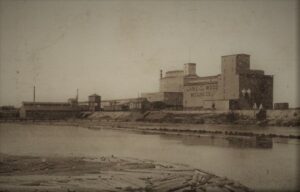Bjarni Sveinsson from Moshól at Síða in W. Skaftafellssýsla came to Canada in 1903 and lived in Manitoba for the first years. A flood from Lake Winnipeg drove him from his land in the Ísafold Settlement and he moved to Keewatin, Ontario, where he bought land just north of a village of the same name. An article about the settlement of Icelanders in this area was published by him in Ólafur Þorgeirsson’s Almanak in 1936. Before we take a look at his account, it should be noted that the name is from the language of the indigenous Cree and means “Northern Blizzard”:
History of Icelanders in Keewatin and the surrounding area

The Lake of the Woods Milling Company was established on May 21, 1887. The location in the center of the country, on the new east-west railway, was great. The grain from the western plain was transported here and ground. The wheat was then sold on the market in the big cities in the east as well as south in the United States.

Keewatin (now Kenora) and Winnipeg are just over 200 km [125 km] apart.
Conclusion
Bjarni then writes stories about 14 Icelanders who settled there. He concludes his speech as follows: “Then I have the least of the Icelanders who have settled in Keewatin and I was able to reach. Icelanders have never been crowded here. At the turn of the century, it was estimated that there were about one hundred Icelanders in Keewatin, and this is when it reached its peak. There are now seventy residents, older and younger. Not included, however are children or young people if one parent is of a nationality other than Icelandic. There are fifteen of these in all from an infant to the age of twenty. Early on, people began to think about the possibility of forming a society. A reading group was then set up, called “Tilraunin”, and a library was established. That library has been around since then and increased Icelandic books and magazines, in connection with that a debating group was formed and a written magazine “Gestur” was published but is now canceled. But the settlement is now busy with the reading society “Tilraunin”, to get Icelandic youth to come together twice a month to read in Icelandic. The new children’s magazine “Baldursbrá” is expected to be used mainly for teaching. No Icelanders here have needed government support. Most people have a permanent job at the wheat and sawmills. In addition, everyone relies on small-scale agriculture, having cows, poultry and gardening. Therefore, all Icelanders who live here have proved to be saviors and some even better”.
Here, of course, is a list of settlers that Bjarni Sveinsson mentioned in his article. More information about each one can be found on a search engine.
1: Hafsteinn Sigurðsson from Efranes in Skagafjarðarsýsla.
2: Jón Pálmason from Bæjum at Snæfjallaströnd.
3: Sigurður Þorgeir Pálmason, half-brother of Jón.
4: Þorkell Magnússon of Gullbringusýsla.
5: Guðjón Hermannsson born at Vatnsleysuströnd.
6: Sigurður Guðmundsson of Gullbringusýsla.
7: Guðný Einarsdóttir from Fáskrúðsfjörður.
8: Karl Jóhann Malmqvist born at Djúpavogur.
9: Ísfeld Úlfarsson of Þingeyjarsýsla.
10: Sigmundur Björnsson from Hnitbjörgum in Jökulsárhlíð.
11: Gísli Jónsson of Skagafjörður.
12. Magnús Sigurðsson of Gullbringusýsla.
13. Sigurður Sigurðsson, half-brother of Magnús.
14: Bjarni Sveinsson of W. Skaftafellssýsla.
English version by Thor Group.
